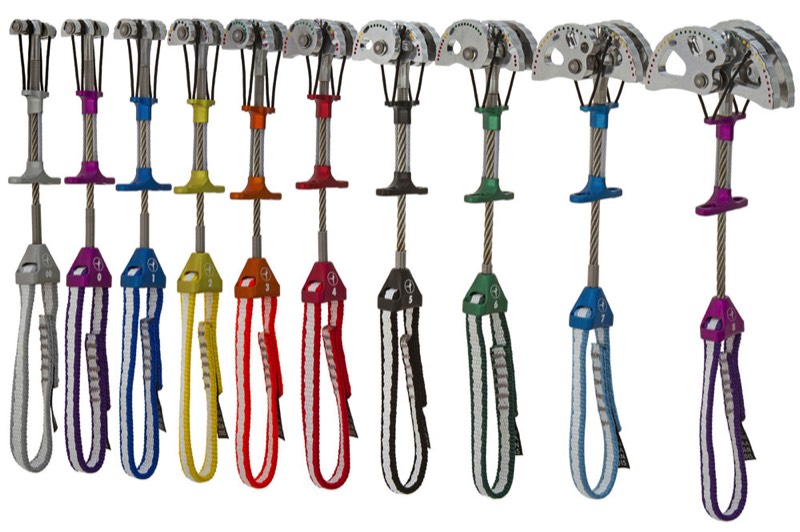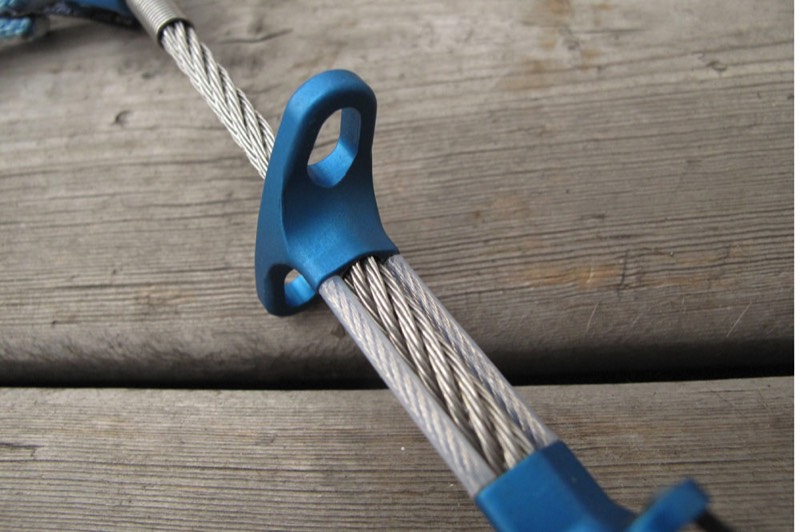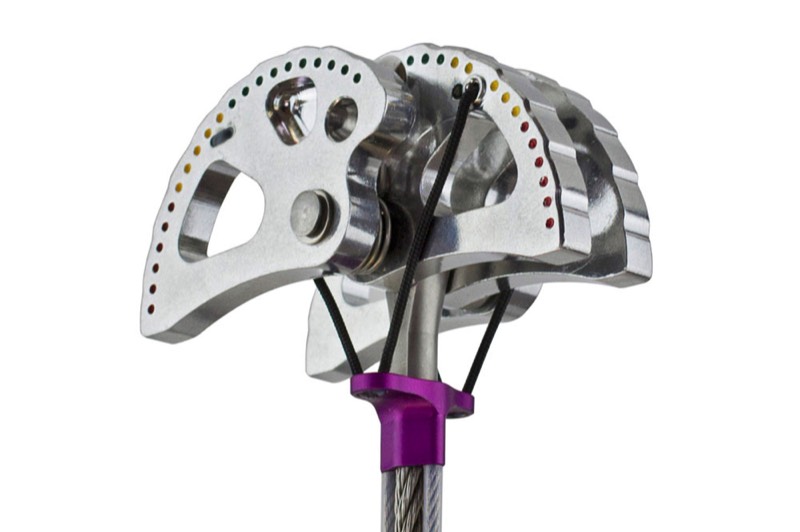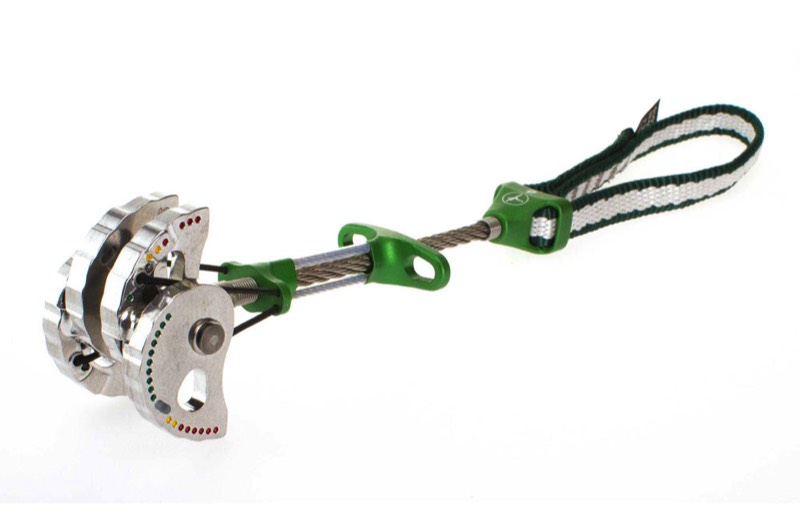Metolius Ultralight Master Cams – Are these the lightest and best cams currently available?
When I recently received a small package from Metolius, I was a bit perplexed. I was waiting for a sample set of their new Ultralight Master Cams, but there was no way this tiny, lightweight package could contain a full set of cams. And I was right, the box did not have a set of cams. Instead, it contained a full set of Ultralight Master Cams as well as a matching set of Metolius’ new FS Mini II carabiners. It was clear that Metolius is a believer of truth-in-advertising – these units are not only shockingly light (an average of 20 percent lighter than the previous Master Cams), but also surprisingly compact.

Metolius Ultralight Master Cams
The new Ultralight Master Cams consist of 10 units ranging in size from the tiny #00 (8.5 - 12.0 mm) to a hand-crack sized #8 (48.5 - 71.5 mm). With the launch of these new cams, Metolius added a #7 and a #8 cam to the line-up, which mirrors the unit sizing found on their time-tested Ultralight Power Cams and Fat Cams. As such, it’s easy for climbers to simply add Ultralight Master Cams to an existing rack of Metolius cams without worrying about how the units overlap.
While many climbers will appreciate the new cam sizes and matching camming range (very worthwhile features), most will be drawn to the new Ultralight Master Cams because of their incredibly low weight. Which brings us to the question of how Metolius has managed to shed weight from their already relatively light first generation Master Cams. And this is where things get interesting.
The first and most obvious difference is that the new Ultralight Master Cams lack the ubiquitous thumb loop. This simple change delivers some substantial weight savings as it eliminates the extra stainless steel cable as well as the chunky swage that used to form the loop. Slightly smaller yet still valuable weight savings also come from not having to use a plastic sheath to cover the thumb loop. The elimination of these three components yields tangible weight reductions, but it also creates a new problem; finding a way to attach the sling to the cam. To fully understand how Metolius solved this issue, let’s get into our DeLorean and crank the time machine back to 1988 – the year when Wild Country released its flexible stemmed Technical Friends. While Technical Friends had a similar flexible-stem construction, they used a relatively heavy stainless thumb stop that was threaded with a 19 mm nylon sling – standard fare for the time. Now here is where Metolius’ design diverges for the better. On the new Ultralight Master Cams, Metolius has replaced that stainless thumb stop with a highly sculpted aluminum unit (with a small silver brazed fitting) that’s threaded with an 11 mm Dyneema sling. Not only is the new thumb stop arrangement significantly lighter, but the addition of a slimmer sling (Metolius used a 13 mm wide sling in the original Master Cams) also helps cut weight. And while other companies (DMM for example) are using a similar aluminum thumb stop, Metolius’ version is lighter and more svelte.
While many climbers will appreciate the new cam sizes and matching camming range (very worthwhile features), most will be drawn to the new Ultralight Master Cams because of their incredibly low weight. Which brings us to the question of how Metolius has managed to shed weight from their already relatively light first generation Master Cams. And this is where things get interesting.
The first and most obvious difference is that the new Ultralight Master Cams lack the ubiquitous thumb loop. This simple change delivers some substantial weight savings as it eliminates the extra stainless steel cable as well as the chunky swage that used to form the loop. Slightly smaller yet still valuable weight savings also come from not having to use a plastic sheath to cover the thumb loop. The elimination of these three components yields tangible weight reductions, but it also creates a new problem; finding a way to attach the sling to the cam. To fully understand how Metolius solved this issue, let’s get into our DeLorean and crank the time machine back to 1988 – the year when Wild Country released its flexible stemmed Technical Friends. While Technical Friends had a similar flexible-stem construction, they used a relatively heavy stainless thumb stop that was threaded with a 19 mm nylon sling – standard fare for the time. Now here is where Metolius’ design diverges for the better. On the new Ultralight Master Cams, Metolius has replaced that stainless thumb stop with a highly sculpted aluminum unit (with a small silver brazed fitting) that’s threaded with an 11 mm Dyneema sling. Not only is the new thumb stop arrangement significantly lighter, but the addition of a slimmer sling (Metolius used a 13 mm wide sling in the original Master Cams) also helps cut weight. And while other companies (DMM for example) are using a similar aluminum thumb stop, Metolius’ version is lighter and more svelte.
Metolius Ultralight Master Cams Thumb Stop
But the weight shedding process does not stop there. Metolius also examined the trigger bar and decided that it could shave a few more grams while improving usability and control by simply removing material from the centre of the trigger wings. It’s a small change, but it demonstrates a commitment to reducing weight without compromising function.

Metolius Ultralight Master Cams Trigger Bar
The point about not compromising function is worth noting because, while Metolius could have drilled out the cam lobes even further for greater weight savings, they chose to leave them alone. Their decision stems from the rational desire of not wanting to compromise the strength and durability of such a critical cam component. And while Metolius has not lightened the lobes, they have updated them with a unique tooth profile (Metolius calls it a shark fin pattern) that offers greater holding power in softer rock.
Speaking of holding power, Metolius continues to use its more conservative and time-tested 13.25-degree camming angle that trades a slight amount of expansion range for significantly greater holding power. For me, this is one of the most compelling reasons to consider Metolius cams when building a rack. Years ago, I had interviewed the owner of Metolius, Doug Phillips, and he mentioned that one in 20 seemingly well-placed cams would unexpectedly pull out during real world testing. And this is not just one of those hypothetical internet-forum “Yer-gonna-die” concerns. Over the years, I’ve had a number of what I thought were solid cams inexplicably pull during a fall, and a very experienced friend had a series of seemingly solid cams pop resulting in a ground fall. The added security afforded by these cams is a real benefit when climbing on polished or slippery rock such as limestone or when placing cams in wet or dirty cracks.
Speaking of holding power, Metolius continues to use its more conservative and time-tested 13.25-degree camming angle that trades a slight amount of expansion range for significantly greater holding power. For me, this is one of the most compelling reasons to consider Metolius cams when building a rack. Years ago, I had interviewed the owner of Metolius, Doug Phillips, and he mentioned that one in 20 seemingly well-placed cams would unexpectedly pull out during real world testing. And this is not just one of those hypothetical internet-forum “Yer-gonna-die” concerns. Over the years, I’ve had a number of what I thought were solid cams inexplicably pull during a fall, and a very experienced friend had a series of seemingly solid cams pop resulting in a ground fall. The added security afforded by these cams is a real benefit when climbing on polished or slippery rock such as limestone or when placing cams in wet or dirty cracks.

Metolius Ultralight Master Cams Shark Fin Lobe Profile
It’s obvious that the Ultralight Master Cams are light and have some cool new features, but do these improvements offer any real benefits when climbing? I got a chance to use the cams this fall during a four-week climbing trip in the Red River Gorge. Between days of clipping bolts on steep enduro-fests, we’d go out and sample the surprisingly good (if somewhat limited) trad climbing at the Gorge.
The first thing I noticed is that with some careful gear choices, which included using the Ultralight Master Cams and their complementary FS II Mini carabiners, the overall weight of my rack was significantly lower. And I’m not talking about a few grams that you can only notice when you pull out the digital scale. Simply lifting the rack was enough to confirm the obvious weight savings. In use, the cams displayed the typical Metolius feel; they were easy to place, and the firm spring tension and snappy action provided a level of confidence that is difficult to describe. Yes, I realize that this is a highly subjective observation, but I still have not found a camming unit that feels as precise (for lack of a better term) as any of the cams coming out of the Metolius factory.
The first thing I noticed is that with some careful gear choices, which included using the Ultralight Master Cams and their complementary FS II Mini carabiners, the overall weight of my rack was significantly lower. And I’m not talking about a few grams that you can only notice when you pull out the digital scale. Simply lifting the rack was enough to confirm the obvious weight savings. In use, the cams displayed the typical Metolius feel; they were easy to place, and the firm spring tension and snappy action provided a level of confidence that is difficult to describe. Yes, I realize that this is a highly subjective observation, but I still have not found a camming unit that feels as precise (for lack of a better term) as any of the cams coming out of the Metolius factory.

Metolius Ultralight Master Cams #6 Unit
The single cable stem offered excellent flexibility in challenging placements (unlike some units sporting plastic-sheathed stems) but never felt floppy and difficult to place (like old Technical Friends). Metolius achieved this seemingly ideal flexibility-to-stiffness ratio by simply using an appropriately sized cable. In fact, they updated some of the cable diameter sizes to further improve the cams’ handling. Which brings us to the new thumb stop. Unlike loop style cams, where you can hold the unit in a syringe-like manner, I preferred placing these cams by simply positioning the stop between the base of my thumb and my palm. For me, this approach seemed faster and was less likely to cause fumbling.
Now here is where dedicated aid climbers (all six of them?) will have a legitimate concern; the lack of a thumb loop prevents climbers from clipping in directly to the piece. Look, it’s hard to argue with this criticism, but it is a bit like complaining that you can’t drive your Bugatti Veyron down to the Motherlode parking lot. If you so desperately need a thumb loop, check out any of the other Metolius cams. Beyond this idiosyncratic concern, I could not find issue with these new cams. They were light, easy to place, held falls and offered a confidence-inspiring level of precision and feel that few cams can match. Throw in the fact that these cams are made in the Metolius factory in Bend, Oregon with US-made materials, and it’s hard to not seriously consider these cams as a top choice for any free climbing situation.
As I’ve said, I’ve used them and in my opinion there currently are no lighter or better small to mid-size cams on the market. Buy these things. You won’t be disappointed.
Now here is where dedicated aid climbers (all six of them?) will have a legitimate concern; the lack of a thumb loop prevents climbers from clipping in directly to the piece. Look, it’s hard to argue with this criticism, but it is a bit like complaining that you can’t drive your Bugatti Veyron down to the Motherlode parking lot. If you so desperately need a thumb loop, check out any of the other Metolius cams. Beyond this idiosyncratic concern, I could not find issue with these new cams. They were light, easy to place, held falls and offered a confidence-inspiring level of precision and feel that few cams can match. Throw in the fact that these cams are made in the Metolius factory in Bend, Oregon with US-made materials, and it’s hard to not seriously consider these cams as a top choice for any free climbing situation.
As I’ve said, I’ve used them and in my opinion there currently are no lighter or better small to mid-size cams on the market. Buy these things. You won’t be disappointed.
You can find out more about the new Metolius Ultralight Master Cams and other Metolius products at www.metoliusclimbing.com.


